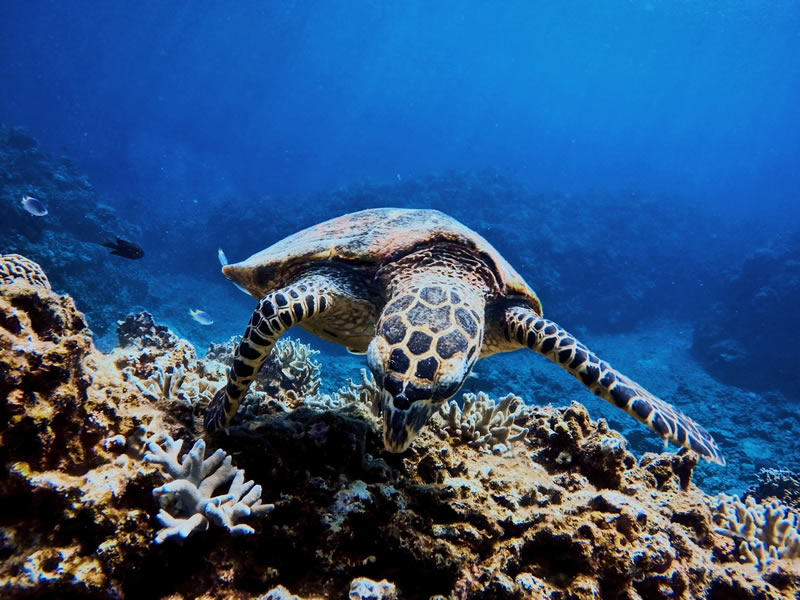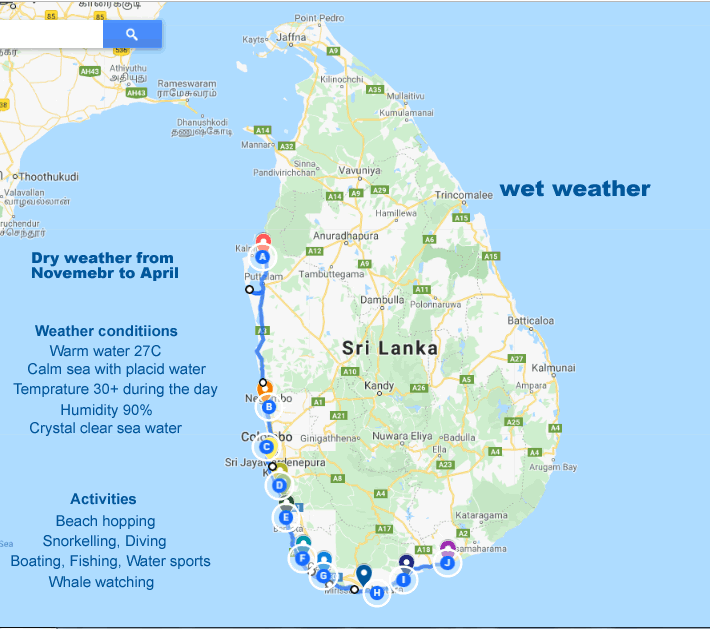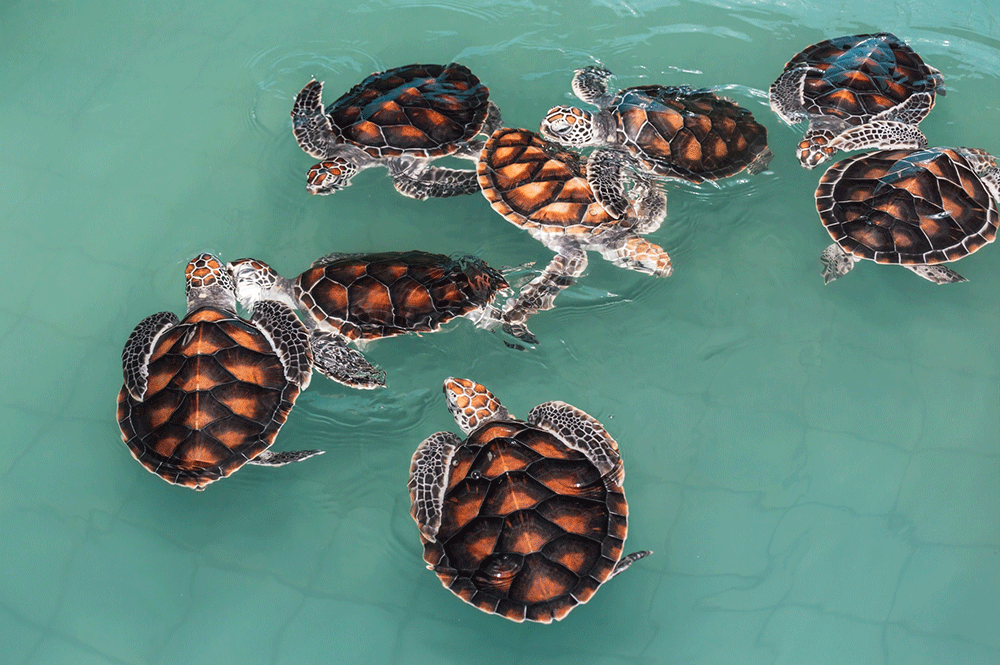Sri Lanka Volunteer Holidays At a Turtle Conservation Centre
Many dozens of sea turtle conservation projects dotted along the western and southern coastal belt, which have become popular places for Sri Lanka volunteer holidays. The sea turtle conservation centres have helped to increase the number of endangered sea turtles in the sea of Sri Lanka. The sea turtle conservation project also provides an opportunity for travellers to take a closer look into 5 species of endangered sea turtles.
Sri Lanka beaches
The beach in Kosgoda, between the Galle-Colombo main road and the Indian ocean, is very spacious, which is exceeds about a hundred meters when the sand filled up from November to April. During the rest of the year, the beach gets narrower as the sea reclaim a portion of the sand that is piled up on the land. This phenomenon of sea erosion and natural sand filling takes place in Kosgoda for many centuries.
But some other natural things dramatically changed over the last several decades, due to human interference, E.g. the population of Sea turtles. With 1300 km of pristine beaches, coves, bays, coral reefs, river mouths and shallow seabed with seagrass are undoubtedly foraging grounds for sea turtles.
West coast beaches such as Kosgoba beach and south coast beaches such as Rekawa beach are the best nesting grounds for sea turtles in Sri Lanka. Therefore, sea turtle conservation centres are to be found along the west and south coast.
Kosgoda sea turtle conservation project is located on the stretch of beach in Kosgoda. A plot of land about 300 sq m is demarcated with a fence, which is alloctaed for the sea turtle conservation project.

Dwindling sea turtle population
Sri Lanka is one of the best places for sea turtles in the world, this opinion can be easily justified upon visiting Rekawa beach in southern Sri Lanka, which is a heaven for nature lovers, where the visitors can see a large number of sea turtles at their natural habitat.
Despite the very favourable natural conditions for sea turtles, ironically, the number of sea turtles visiting the island drastically dwindled in the past. The sea turtle population became so meagre, the government had declared it as a protected animal in Sri Lanka. Under the Fauna and Flora Protection Ordinance (FFPO, 1938 amended in 1972, 1993), it is a punishable offence to capture, kill, injure or possess sea turtles or their eggs without the permission of the government.
How to manage the dwindling sea turtle population is a question not only for Sri Lanka but also for the entire world. Because the sea turtle population has been on the downward trend all around the world due to a myriad of reasons. IUCN has included 6 species of sea turtles into its red list, namely Kemp’s ridley sea turtle (Lepidochelys kempii), Flatback sea turtle (Natator depressus), Leatherback sea turtle (Dermochelys coriacea), olive ridley sea turtle (Lepidochelys olivacea), green sea turtle (Chelonia mydas), hawksbill sea turtle (Eretmochelys imbricata), foreseeing its imminent extinction if not suitable action is taken to protect it.
Sri Lanka volunteer holidays: Sea turtle conservation effort
Sea turtles extinct or reduced to a negligible number of animals already in many parts in the world. On the other hand, spotting sea turtles has also become more difficult, where it was abundance in the past. The major nesting beaches of Sri Lanka for sea turtles are confined to western and southern coastal areas. Most sea turtle conservation centres dotted along the western and southern coastal belt. The sea turtle conservation centres are managed by a private organization and some of these places make room for volunteers.
Despite the fact that many sea turtle conservation centres have been under heavy criticize, some of the conservation centres seem to be doing an invaluable service. It is believed that these projects have helped the sea turtle population stabilize and even increased slightly.
The government also has tightened its effort of conserving sea turtle in the state level and has taken many steps in its endeavour. Killing of sea turtle and possessing sea turtle or its eggs is now a heavily punishable offence that comes with jail period as well as financial loss.
NGO’s and Non-NGO’s also has been on the battlefield while launching, many awareness programs to convince the coastal community about the importance of Sea turtles.
Eating sea turtles and its eggs had been a habit of people in the coastal areas, however, the consumption of sea turtles has been considerably reduced over the last few years.
Sri Lanka volunteer holidays at a sea turtle conservation centre
Thanks to the development of the tourism industry, now it is branching to many other areas such as wildlife tourism, health tourism and voluntarism. Many tour operators such as Seerendipity offers volunteering holiday packages based on sea turtle conservation centres such as 5 days Sri Lanka volunteering. Therefore, the travellers now able to spend their holidays while taking conservation effort of sea turtles.
The working at the sea turtle conservation centre is not as hard as many other animal conservation efforts such as elephant conservation or leopard conservation. These conservation centres are mainly educating the visitors about the sea turtles and volunteers are entrusted of educating the visitors. Cleaning sea turtle tanks, feeding sea turtle, making their food and taking care of sea turtle eggs until the hatchling see the light are also few important activities in the conservation centre.
There is a permanent staff in the conservation centre with the volunteers, therefore you can spend a few nights eating dinner around a beach fire, take part in tours and activities or plunge into the Indian ocean.
There is no hard and fast rule to take part in the volunteer Sri Lanka volunteer holidays. You are not required to possess a work permit like in most other countries.
Sri Lanka volunteer holidays: duration
Seerendipity tours offer 2 to 3 weeks Sri Lanka volunteer holidays with many sea turtle conservation projects on the western and southern Sri Lanka. Volunteers live in comfortably middle-class rooms with air-conditioning. They will be accommodated in a beachfront middle-class hotel with easy access to all saltwater activities.
“The number of travellers looking for Sri Lanka volunteer holidays is considerably increased over the last few years. The interest in sea-turtle conservation is considerably heightened. We get teachers, bankers, and dinner ladies, come to our conservation centre, looking for something totally different and useful and live the life of a conservationist, “explained Dudley, the Manager of the Projects.
Sea turtle distribution map

Main objectives of Sri Lanka volunteer holidays at sea turtle centre
The main objective of the sea turtle conservation centre is to take care of the wounded sea turtles. Releasing as many baby turtles as possible to the see is another priority of the conservation effort.
The killing of grownup sea turtles for their meat and scutes had been largely reduced with the introduction of the new law. Sadly, some people on the coastal area still eating the turtle eggs. The sea turtle conservation centres encourage the people on the coastal areas to sell the eggs that they find on the beach and conservationist spend higher rate to buy them. Later they hatch the eggs within the conservation centres and release the babies to the sea.
The fishing nets are another serious threat to this endangered animal. Sea turtles are entangled in fishing next some times and make them seriously wounded. These wounds so serious some times the animal become disabled E.g. losing the legs and arms, due to these serious wounds the animals are not able to return to the sea. In such situations, the conservation centres provide the shelter to these disabled animals for the rest of their life.
When is the best time for Sri Lanka volunteer holidays?
Generally, November to April considered being the best time to travel to Sri Lanka. During this period the southern and west coast of Sri Lanka experience dry weather. If you are venturing on a sea turtle volunteering holidays, having the best time is critical for the success of your volunteering trip. The 6 months from November to April, the sea off west and southern coast become very calm and the effect of underwater current diminishes. Due to the absence of underwater current, during this period the turtles come to the shore more often and rest of the year.
Sri Lanka volunteer holidays at Kosgoda
Kosgoda turtle conservation project is a volunteer program that is actively engaged in the conservation of sea turtles. The conservation project launched 25 years back still collecting turtle eggs from the village in order to hatch. The conservation project also provides shelter to disabled animals due to fishing nets.
The volunteers are welcome to help with conservation effort at the Kosgoda conservation centre, during the volunteer holidays the visitors suppose to help with various jobs such as cleaning the turtle tanks, changing water, feeding animals, preparing their food etc.
Swimming with sea turtle
Swimming with a sea turtle is a popular activity among travellers in Sri Lanka. The 6 months from November to April is the best time to swim with sea turtles as most part of the sea become calm and attracts sea turtles. There are several places along the western and southern coast, such as turtle beach Mirissa, Huikkadua, and Unawatuna, where a large number of sea turtles can be witnessed.






